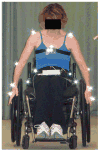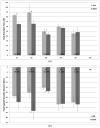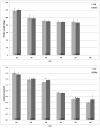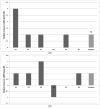Effects of intramuscular trunk stimulation on manual wheelchair propulsion mechanics in 6 subjects with spinal cord injury
- PMID: 23628377
- PMCID: PMC4103696
- DOI: 10.1016/j.apmr.2013.04.010
Effects of intramuscular trunk stimulation on manual wheelchair propulsion mechanics in 6 subjects with spinal cord injury
Abstract
Objective: To quantify the effects of stabilizing the paralyzed trunk and pelvis with electrical stimulation on manual wheelchair propulsion.
Design: Single-subject design case series with subjects acting as their own concurrent controls.
Setting: Hospital-based clinical biomechanics laboratory.
Participants: Individuals (N=6; 4 men, 2 women; mean age ± SD, 46 ± 10.8y) who were long-time users (6.1 ± 3.9y) of implanted neuroprostheses for lower extremity function and had chronic (8.6 ± 2.8y) midcervical- or thoracic-level injuries (C6-T10).
Interventions: Continuous low-level stimulation to the hip (gluteus maximus, posterior adductor, or hamstrings) and trunk extensor (lumbar erector spinae and/or quadratus lumborum) muscles with implanted intramuscular electrodes.
Main outcome measures: Pushrim kinetics (peak resultant force, fraction effective force), kinematics (cadence, stroke length, maximum forward lean), and peak shoulder moment at preferred speed over 10-m level surface; speed, pushrim kinetics, and subjective ratings of effort for level 100-m sprints and up a 30.5-m ramp of approximately 5% grade.
Results: Three of 5 subjects demonstrated reduced peak resultant pushrim forces (P≤.014) and improved efficiency (P≤.048) with stimulation during self-paced level propulsion. Peak sagittal shoulder moment remained unchanged in 3 subjects and increased in 2 others (P<.001). Maximal forward trunk lean also increased by 19% to 26% (P<.001) with stimulation in these 3 subjects. Stroke lengths were unchanged by stimulation in all subjects, and 2 showed extremely small (5%) but statistically significant increases in cadence (P≤.021). Performance measures for sprints and inclines were generally unchanged with stimulation; however, subjects consistently rated propulsion with stimulation to be easier for both surfaces.
Conclusions: Stabilizing the pelvis and trunk with low levels of continuous electrical stimulation to the lumbar trunk and hip extensors can positively impact the mechanics of manual wheelchair propulsion and reduce both perceived and physical measures of effort.
Keywords: Electrical stimulation; FEF; GME; MANOVA; Neural prostheses; Posture; ROM; Rehabilitation; SCI; Spinal cord injuries; Torso; URS; Usability Rating Scale; fraction of effective force; gross mechanical efficiency; multivariate analysis of variance; range of motion; spinal cord injury.
Copyright © 2013 American Congress of Rehabilitation Medicine. Published by Elsevier Inc. All rights reserved.
Figures





Similar articles
-
Effects of stimulating hip and trunk muscles on seated stability, posture, and reach after spinal cord injury.Arch Phys Med Rehabil. 2013 Sep;94(9):1766-75. doi: 10.1016/j.apmr.2013.02.023. Epub 2013 Mar 13. Arch Phys Med Rehabil. 2013. PMID: 23500182 Free PMC article. Clinical Trial.
-
Implanted electrical stimulation of the trunk for seated postural stability and function after cervical spinal cord injury: a single case study.Arch Phys Med Rehabil. 2009 Feb;90(2):340-7. doi: 10.1016/j.apmr.2008.07.029. Arch Phys Med Rehabil. 2009. PMID: 19236990 Free PMC article.
-
Manual wheelchair pushrim biomechanics and axle position.Arch Phys Med Rehabil. 2000 May;81(5):608-13. doi: 10.1016/s0003-9993(00)90043-1. Arch Phys Med Rehabil. 2000. PMID: 10807100
-
Pushrim biomechanics and injury prevention in spinal cord injury: recommendations based on CULP-SCI investigations.J Rehabil Res Dev. 2005 May-Jun;42(3 Suppl 1):9-19. doi: 10.1682/jrrd.2004.08.0103. J Rehabil Res Dev. 2005. PMID: 16195959 Review.
-
Exploring the biomechanical link between wheelchair propulsion, shoulder injury and shoulder pain: A scoping review.J Biomech. 2025 May;185:112678. doi: 10.1016/j.jbiomech.2025.112678. Epub 2025 Apr 10. J Biomech. 2025. PMID: 40250244
Cited by
-
Automatic application of neural stimulation during wheelchair propulsion after SCI enhances recovery of upright sitting from destabilizing events.J Neuroeng Rehabil. 2018 Mar 12;15(1):17. doi: 10.1186/s12984-018-0362-2. J Neuroeng Rehabil. 2018. PMID: 29530053 Free PMC article. Clinical Trial.
-
Augmented feedback for manual wheelchair propulsion technique training in a virtual reality simulator.J Neuroeng Rehabil. 2021 Sep 21;18(1):142. doi: 10.1186/s12984-021-00936-x. J Neuroeng Rehabil. 2021. PMID: 34548085 Free PMC article. Clinical Trial.
-
Feedback control of upright seating with functional neuromuscular stimulation during a reaching task after spinal cord injury: a feasibility study.J Neuroeng Rehabil. 2022 Dec 12;19(1):139. doi: 10.1186/s12984-022-01113-4. J Neuroeng Rehabil. 2022. PMID: 36510259 Free PMC article.
-
Intrinsic and Extrinsic Contributions to Seated Balance in the Sagittal and Coronal Planes: Implications for Trunk Control After Spinal Cord Injury.J Appl Biomech. 2015 Aug;31(4):221-8. doi: 10.1123/jab.2013-0307. Epub 2015 Mar 17. J Appl Biomech. 2015. PMID: 25780873 Free PMC article.
-
Real-Time In Vivo Control of Neural Membrane Potential by Electro-Ionic Modulation.iScience. 2019 Jul 26;17:347-358. doi: 10.1016/j.isci.2019.06.038. Epub 2019 Jul 5. iScience. 2019. PMID: 31326701 Free PMC article.
References
-
- Birmingham: National Spinal Cord Injury Statistical Center; 2011. Spinal Cord Injury Facts and Figures at a Glance. www.nscisc.uab.edu/public_content/pdf/Facts%202011%20Feb%20Final.pdf.
-
- Berkowitz M, Harvey C, Greene C, Wilson S. The Economic Consequences of Traumatic Spinal Cord Injury. New York NY: Demos; 1992.
-
- Sinnott KA, Milburn P, McNaughton H. Factors associated with thoracic spinal cord injury, lesion level and rotator cuff disorders. Spinal Cord. 2000;38:748–753. - PubMed
-
- Anderson KD. Targeting recover: priorities of the spinal cord-injured population. Journal of Neurotrauma. 2004;21(10):1371–1383. - PubMed
-
- Boninger ML, Towers JD, Cooper RA, Dicianno BE, Munin MC. Shoulder imaging abnormalities in individuals with paraplegia. Journal of Rehabilitation Research & Development. 2001;38(4):401–409. - PubMed
Publication types
MeSH terms
Grants and funding
LinkOut - more resources
Full Text Sources
Other Literature Sources
Medical
Research Materials

